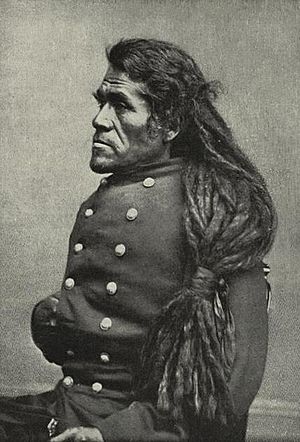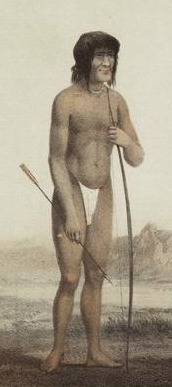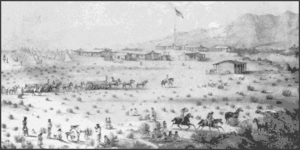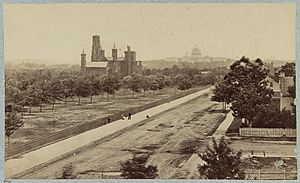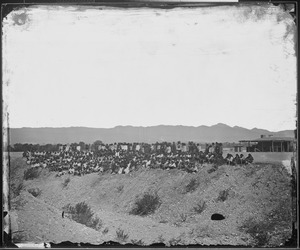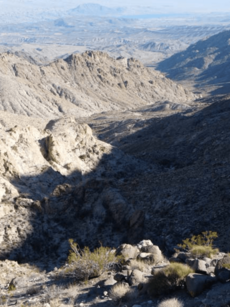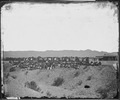Irataba facts for kids
Quick facts for kids
Irataba
|
|
|---|---|
|
Yara tav
|
|
|
Irataba, c. 1864
|
|
| Mohave leader | |
| Personal details | |
| Born | c. 1814 Arizona |
| Died | May 3 or 4, 1874 (aged 59–60) Colorado River Indian Reservation, Arizona Territory, United States |
| Mother tongue | Mohave |
Irataba (Mohave: eecheeyara tav, also known as Yara tav; born around 1814 – died 1874) was an important leader of the Mohave Nation. He was known for helping the Mohave and the United States get along. Irataba was born near the Colorado River in what is now Arizona. He was a famous speaker and one of the first Mohave people to learn English. This skill helped him build relationships with the United States.
Irataba first met European Americans in 1851 when he helped the Sitgreaves Expedition. In 1854, he met Amiel Whipple, who was leading a group across the Colorado River. Irataba agreed to guide them through Paiute lands to the Old Spanish Trail. This trail would take them to southern California. Irataba was known for being tall and kind. He helped and protected other expeditions, which made white settlers see him as a very important Native leader in the area.
Contents
Who Was Irataba?
Irataba's name, also spelled Ireteba, means "beautiful bird" in the Mohave language. He was born around 1814 into the Sun Fire clan of the Mohave Nation. He lived near a rock formation that gave its name to Needles, in present-day Arizona. The Mohave people lived in homes along the Colorado River. In winter, they built half-buried houses from cottonwood logs and earth. In summer, they used open-air, flat-roofed houses called ramadas.
In the mid-1800s, the Mohave were divided into three groups. Irataba was a leader of the Huttoh Pah group. This group lived near the east bank of the Colorado River. The Mohave government had a system of hereditary clan leaders and a head leader for the whole nation. They often had conflicts with the Chemehuevi, Paiute, and Maricopa peoples. Irataba was part of the Mohave warrior society called kwanami. These warriors defended their lands and people.
Not much is known about Irataba's family. We know his son was named Tekse thume. His nephews were Qolho qorau and Aspamekelyeho. Olive Oatman, a white girl who lived with the Mohave for five years, said Irataba was the brother of a former chief. Irataba was described as a great speaker. He was one of the first Mohave to speak English well, learning it from his many interactions with Anglo-Americans. Like many Mohave men, Irataba was very tall for his time. The US Army estimated he was 6 feet 4 inches (193 cm) tall in 1861. An American author called him "the old desert giant." A soldier who knew Irataba described him as strong but also "very gentle" and "kind."
Irataba lived during a time when the Mohave people went from being independent to being controlled by the United States. His role in these changes is well documented. Most information about Irataba comes from white explorers or government agents. Newspapers also reported on his visits to the East Coast. Some Mohave stories about these events also exist.
Meeting Explorers and Settlers
Irataba helped Captain Lorenzo Sitgreaves during his 1851 exploration of the Colorado River. In 1851, a family of settlers, the Oatmans, were attacked by Yavapai people in Arizona. Two sisters, 14-year-old Olive Oatman and 7-year-old Mary Ann, were captured. After a year, they were sold to the Mohave. Olive lived with the Mohave for five years. Irataba may have learned about Anglo-Americans from Olive Oatman. Knowing her might have made him more open to friendly relations with white people.
Whipple Expedition
On February 23, 1854, Irataba, Cairook, and other Mohave people met an expedition led by military officers Amiel Whipple and J.C. Ives. The Mohave traded corn, beans, squash, and wheat for beads and cloth. The Mohave and the expedition members played games and practiced shooting. When the expedition had trouble crossing the Colorado River, several Mohave helped them.
Irataba and Cairook agreed to guide the group through Paiute territory to the Old Spanish Trail. A German artist, Balduin Möllhausen, drew pictures of several Mohave, including Irataba. These drawings were published in a government report, making Irataba one of the first named California Indians to have his likeness published.
Ives Expedition
In February 1858, Ives returned to the area in a steamboat called Explorer. He wanted Irataba to guide them up the Colorado River. The Mohave allowed them to travel on the river. Cairook, Irataba, and a 16-year-old Mohave boy joined the expedition. Möllhausen was again impressed by the Mohave guides. He noted Irataba's friendly handshake. He also saw that Irataba and the Mohave were interested in European clothes and smoking tobacco.
Irataba guided the group into the Mohave Canyon, showing them where rapids were. He also advised the pilot where to anchor for the night. The ship later crashed into a rock, damaging it. The expedition's supplies were running low. Irataba volunteered to hike to the Mohave Valley to find supplies. He also warned that Paiutes were watching the expedition.
When Irataba returned, he said he would not go deeper into Hualapai territory. However, he agreed to help them find friendly guides before leaving. Irataba was worried about being ambushed by Paiutes. On April 4, the Mohave were paid for their help. Ives gave Irataba two mules for his loyalty. Möllhausen wrote that Irataba was sad to leave, showing his honesty and loyalty.
Mohave War and Its Effects
After meeting explorers and soldiers, the Mohave knew that more white people were moving into their region. Some white people, like Whipple, were friendly. Others, like the Mormons, were not. The Mohave warriors were divided on how to deal with this. Some wanted to fight and stop whites from passing through their land. Others, including Irataba, wanted peace or even an alliance with the US. This alliance could help the Mohave against their traditional enemies.
In 1857, Mohave and Quechan warriors attacked a Maricopa village. This battle, called the Battle of Pima Butte, was fought with clubs, bows, and arrows. Many warriors died. It is not known if Irataba fought, but it is likely given his status. This defeat made the Mohave worried that whites would try to settle on their lands.
Attack on the Rose–Baley Party
In 1857, Edward Fitzgerald Beale was tasked with creating a trade route from Arkansas to Los Angeles. This route became known as Beale's Wagon Road. In 1858, the Rose–Baley Party, a group of over a hundred settlers, was the first to use this road. When they entered Mohave territory, the settlers started cutting down cottonwood trees. These trees were important to the Mohave.
Some Mohave warriors attacked the party. They drove away and killed many of their cattle. On August 30, three hundred Mohave warriors attacked the settlers. One settler was killed and eleven were wounded. The settlers killed seventeen Mohave warriors. This incident was widely reported and called a "massacre." It made many white Californians fear being cut off from the eastern US. This led the US War Department to act quickly against the Mohave.
Irataba was away at Fort Yuma during the attack. When he heard about it, he scolded the Mohave warriors. He told them they would have war again. Irataba, tired of constant fighting, organized a peace trip to the Maricopa. He helped settle old disputes between the two peoples.
Conflict with the US Army
The US War Department decided to build a military fort at Beale's Crossing. This fort would control the Mohave and protect white travelers. In December 1858, Colonel William Hoffman was sent to confront the Mohave. Irataba tried to arrange a peaceful meeting. But Hoffman ordered his troops to fire on the warriors.
Hoffman returned in April 1859 with more soldiers. The Mohave decided not to attack the army of five hundred soldiers. On April 23, Hoffman met with Mohave leaders, including Cairook, Irataba, and Homoseh quahote. During the meeting, armed soldiers surrounded the Mohave leaders.
Hoffman gave the Mohave a choice: war or peace. He demanded that they never harm white settlers again. He also demanded that they surrender hostages from each clan. Cairook offered himself as a hostage, along with eight others, including Irataba's son Tekse thume and his nephews. They were taken to Fort Yuma. Soldiers stayed to build Fort Mohave. Irataba visited the fort many times to argue for their release. But the hostages were held for over a year. On June 21, 1859, Cairook and another captive were killed while trying to escape. Most of the other Mohave captives escaped.
In July 1861, the commander of Fort Mohave, Major Lewis Armistead, ordered soldiers to fire into a group of Mohave. He suspected them of attacking a mail carrier. The Mohave did not fight back violently. But Armistead decided to punish them. He went to Irataba's ranch, where Mohave boys were planting beans. He shot and killed one of the planters. This attack led to a battle where many Mohave were killed. The Mohave remember this as "the first and last battle with the Federal Troops."
Irataba as a Mohave Leader
After Cairook's death, white settlers saw Irataba as the main leader of the Mohave. He became Aha macave yaltanack (leader of the Mohave Nation) or hochoch (leader elected by the people). The position of head of the Mohave was traditionally inherited. But Irataba was elected. This meant that Homoseh quahote, the hereditary leader, had to step down for Irataba to take his place.
Mohave leaders were not like "rulers" or "bosses." As an elected leader, Irataba was mainly a servant of his tribe. By the mid-1860s, there was a big difference between Irataba and Homoseh quahote. Irataba actively worked with white settlers. Homoseh quahote tolerated them but did not approve of them taking Mohave lands. Irataba was the leader of the Mohave from 1861 to 1866. Later, Homoseh quahote became the leader of the Fort Mohave group.
Mining and Travels
Mining Ventures
Irataba helped bring attention to the gold in the region. In 1861, Mohave people, possibly including Irataba, helped prospectors find gold in Eldorado Canyon. This led to the first mining rush in the area. Later, Irataba led a man named John Moss to a rich gold mine. In 1863, Irataba guided gold prospectors, including Joseph R. Walker. He led them to a river he called Hasyamp, which was later named the Hassayampa River. They found a lot of gold there. This led to the founding of Prescott, Arizona.
Relations between settlers and the Mohave were good during this time. But as more people moved in, gold seekers founded towns. This made settlers fear a Native uprising. Later, soldiers found a lot of copper ore near Fort Mohave. This area was named Irataba Mining District. A small mining town called Irataba City was also built. Mining became well established in the Mohave lands.
Travels to the East Coast
In the early 1860s, Irataba became friends with prospectors, including John Moss. Moss suggested that Irataba be invited to Washington, D.C. This way, Irataba could see the United States' military power. In November 1863, Irataba traveled with Moss to San Francisco. He stayed at a hotel and caused a stir when he walked down the street in European-American clothes. He soon preferred these clothes to traditional Mohave clothing. The newspapers wrote a lot about him, describing his size and strong features.
In January 1864, they sailed to New York City. Harper's Weekly described him as "the finest specimen of unadulterated aboriginal on this continent." In New York, Irataba changed his suit for a major general's uniform. It included a bright yellow sash and a gold badge. When The New York Times asked him why he was visiting, he said: "to see where so many pale faces come from." In New York, he met Olive Oatman again. They spoke in Mohave. Irataba told Oatman that her Mohave adoptive sister still missed her.
Irataba then went to Philadelphia and Washington, D.C. He was very popular. Government officials and military officers gave him gifts like medals and swords. In Washington, he met President Abraham Lincoln, who gave him a silver-headed cane. He was the first Native American from the Southwest to meet an American president. The tour ended in April, and he returned to California.
When Irataba returned home, he met with the Mohave wearing his major general's uniform and medals. He told them about all the things he had seen. He tried to convince them that peace with the United States was best for them. He stressed how powerful the US military was. Many Mohave were doubtful of his stories.
Colorado River Indian Reservation
After Fort Mohave was built, the next step was to create reservations. In 1863, Charles Debrille Poston, the first Superintendent of Indian Affairs for the Arizona Territory, met with the Chemehuevi and Irataba's group of Mohave. He convinced them to form an alliance with the US against the Apache. This helped build friendly relations between the Mohave and the US government.
Poston wanted to create a reservation in the southern part of Mohave country. Many Mohave did not like this location. They wanted a smaller area further north in the Mohave Valley, which had more fertile land. Poston traveled with Irataba to survey a location. In August 1864, the commander at Fort Mohave said Irataba was against the proposed location. But in September 1864, Poston made it seem like Irataba was in favor of it.
To convince Irataba, Poston promised that the US government would help the Mohave build an irrigation system. This system would make most of the reservation land good for farming. This promise seemed to convince Irataba. He traveled to the Colorado River Valley with about 800 people. This was almost a fifth of the entire Mohave Nation. On March 3, 1865, Congress created the Colorado River Indian Reservation at Poston's suggested location. However, the promised irrigation help never fully came. The soil was also too alkaline for farming. The reservation was created without a formal treaty between the Mohave and the US government.
Most of the Mohave refused to leave their traditional lands for the reservation. They stayed to follow Homoseh quahote, their hereditary leader. But Irataba believed the reservation was their best choice. This caused a split between his group and those who stayed behind.
Since the irrigation help was not immediate, the first year on the reservation brought a drought. The Mohave had to ask for food. In 1867, Irataba and the Mohave began to build an irrigation canal by hand. It was 9 miles (14 km) long. By 1870, only about 40 acres (16 hectares) of land were being farmed on the reservation.
Later Years and Legacy
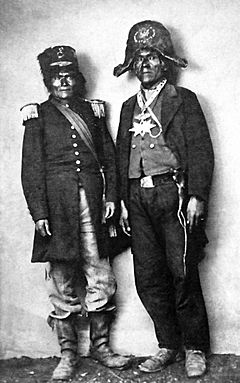
Irataba continued to lead the Colorado River band of Mohave during the 1860s. He worked for peaceful relations with nearby tribes. He also cooperated with US authorities. He helped the Yavapai and Walapai in their conflicts with the Paiutes and Chemehuevi.
In March 1865, Irataba and the Mohave defeated the Chemehuevi. This happened after the Paiutes killed two Mohave women. The Mohave pushed the Chemehuevi off their land. In October 1865, during another battle with the Chemehuevi, Irataba was captured. He was wearing his major general's uniform. His captors feared killing him would bring trouble from Fort Mohave soldiers. So, they sent him home badly beaten. In the Mohave story, Irataba surrendered to make peace. He offered his uniform to the Chemehuevi chief as a sign of peace. In 1867, Irataba and the Chemehuevi leader Pan Coyer signed a treaty. This brought peace between the two nations.
Irataba also welcomed Yavapai groups onto the reservation. They had suffered massacres by US troops or faced starvation. But the reservation's resources were too small for everyone. The Yavapai eventually had to leave. Irataba often helped mediate between Yavapai and Walapai who were fighting the US army. In 1871–72, General George Crook came to the Mohave reservation. He was looking for Yavapai thought to be responsible for the Wickenburg Massacre. Irataba had to turn the war party over to the army. The Yavapai felt betrayed by Irataba. They plotted to kill him for revenge. But they were later convinced that he was not the one who had turned them over.
The Colorado River band of Mohave never replaced Irataba as their leader. He died on their reservation on May 3 or 4, 1874. The cause of his death is unknown. Some say it was smallpox, others natural causes. The Mohave grieved deeply. Irataba's cremation and mourning rituals were reported in newspapers far away. His nephew, Qolho qorau, succeeded him as leader on the Colorado Reservation. He continued Irataba's policies.
Irataba's Influence
Irataba's legacy among the Mohave is seen in different ways. Some see him as a hero. Others believe he worked too closely with white people and did not stand up enough for Mohave rights. However, from the perspective of the white settlers, he was a Mohave leader who always worked for peace.
Irataba's influence might even have changed the Mohave language. He was among the first Mohave speakers to change certain sounds in the language. By the late 1800s, all Mohave speakers had adopted this change. Some believe this was partly due to Irataba's influence. He was a respected leader, and others may have copied his way of speaking. Also, when he led the Mohave to the reservation, different ways of speaking blended together, helping new changes spread quickly.
The Irataba Society is a non-profit charity run by the Colorado River Indian Tribes. It was started in Parker, Arizona, in 1970. This charity holds an annual pow wow celebration. Irataba Hall, a sports venue in Parker, is also named after him. In 2002, the US Bureau of Land Management named 32,745 acres (13,251 hectares) in the Eldorado Mountains as Ireteba Peaks Wilderness.
In March 2015, the Colorado River Indian Tribes celebrated 150 years of their reservation. Speakers at the event highlighted Irataba's strong leadership in creating and keeping the reservation. Tribal chairman Dennis Patch said that Irataba "made sure the Mohaves stayed on land they had lived on since time immemorial." Former CRIT Museum Director Dr. Michael Tsosie said, "Irataba understood the Mohave people would need to keep fighting to keep what they had." He noted that the Colorado River Indian Reservation is special because it has not lost any land.
Images for kids
-
Irataba (right) with Yavapai leader Ohatchecama, photographed at the trial following the Wickenburg Massacre (Library of Congress photograph collection)
See also
 In Spanish: Irataba para niños
In Spanish: Irataba para niños


